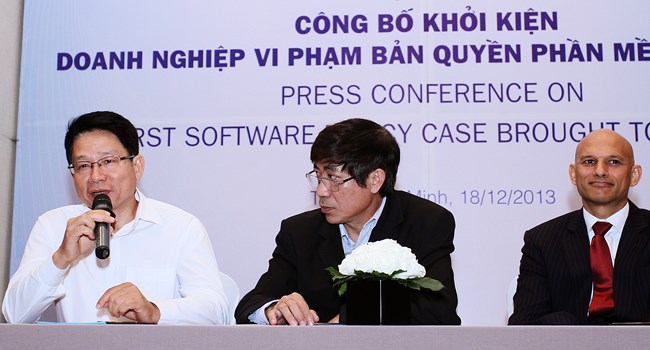|
How to calculate
damage caused by software piracy?
International
organizations regularly announce the figures about the damage caused by the
use of unlicensed software. However, it’s still unclear how reliable the
figures are.

Ha Than, first
left, announces the $50 million loss for Lac Viet software illegal use.
Ha Than, CEO of Lac Viet, announced at
a recent press conference on the lawsuit against Gold John Dong Nai Vietnam
International Company Ltd, a Taiwanese invested enterprise--for its software
piracy, that Lac Viet has lost $50 million as its Lac Viet dictionary, one of
its software product very popularly used in Vietnam, has been used without
license.
According to Than, there are some 18
million computers, mobile devices and smart phones in
Even if noting that the piracy rate
is 90 percent (lower than the rate announced by BSA), and there are 10
million computers (instead of 18 million as estimated), the total loss Lac
Viet has incurred in the last 18 years would be $50 million.
However, analysts look at the figure
with dubious eyes. Lac Viet was marketed in 1995, when the number of
computers and mobile devices was far below 18 million.
At that time, Lac Viet was not used
so widely. It took Lac Viet many years to popularize the software. In many
cases, Lac Viet dictionary software has been used as the gift.
Meanwhile, in recent years, with the
tablet and smart phone boom, people have many other choices than Lac Viet.
There are a lot of free dictionary versions on Google Play or Apple App Store
for people to download.
Therefore, analysts have every reason
to think that the $50 million is an unrealistic figure. The calculator, when
calculating the damage, missed a lot of the factors on the social
development, the popularity of mobile devices and intellectual standards of
people which might affect the results.
In fact, analysts say, the figures
about the software piracy rates and the damage caused by the use of
unlicensed software announced so far in
In May 2010, BSA and IDC both
announced the software piracy rate in
BSA, one year later, announced the
piracy rate at 83 percent for 2010.
A government official said that the
figures released by foreign institutions and associations sometimes are
unreliable. However, the figures released by BSA, an
Lao Dong
|
Thứ Tư, 25 tháng 12, 2013
Đăng ký:
Đăng Nhận xét (Atom)
Không có nhận xét nào:
Đăng nhận xét